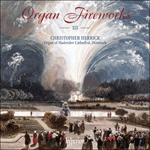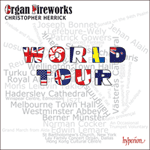The Czech composer Petr Eben was born in 1929 and died in 2007. His
Hommage à Buxtehude, subtitled
Toccatenfuge, was commissioned by the Ministry of Education and Cultural Affairs of Schleswig-Holstein, who clearly plumped for Oldesloe as the place of Buxtehude’s birth and regarded ‘circa 1637’ as justifying 350th anniversary celebrations in 1987, to which year the work belongs. The score has a preface comprising quotations from the first bar of BuxWV137 and the first fugue-subject of BuxWV148. The first section,
Con enfasi, ma più Allegro che Buxtehude, is based on the first bar of the C major work and constitutes a brilliant, improvisatory introduction. The second,
Ben ritmico, dwells on the repeated-note fugue-subject of the G minor work, making occasional references to the C major pedal solo. The third,
Scherzando, also based on the G minor fugue-subject, is fugal in character. The last movement,
Tempo I, is a stunning toccata based on the rhythm of Buxtehude’s pedal solo, the outline of the G minor fugue-subject contributing increasingly powerful commentaries from the pedals. Buxtehude’s musical vocabulary was such that he would almost certainly have been bewildered by Eben’s work, fine though it is; but he could hardly fail to be moved by the highly inventive use it makes of his material, or fail to see in the work as a whole something of his own apparent joie de vivre.
from notes by Relf Clark © 2008
Le compositeur tchèque Petr Eben naquit en 1929 et mourut en 2007. Son
Hommage à Buxtehude, sous-titré
Toccatenfuge, répondit à une commande du Ministère de l’éducation et des affaires culturelles du Schleswig-Holstein, qui fit clairement naître Buxtehude à Oldesloe et estima «circa 1637» suffisant pour fêter en 1987 le trois cent cinquantième anniversaire de sa naissance, célébration dans le cadre de laquelle l’œuvre d’Eben s’inscrivit. La préface de la partition cite la première mesure de BuxWV137 et le premier sujet de fugue de BuxWV148. La section initiale,
Con enfasi, ma più Allegro che Buxtehude, repose sur la première mesure de l’ouvrage en ut majeur et est une brillante introduction à l’improvisade. La deuxième,
Ben ritmico, se fonde sur un sujet de fugue en notes répétées de la composition en sol mineur, avec quelques références au solo de pédalier en ut majeur. La troisième,
Scherzando, s’appuie sur ce même sujet de fugue en sol mineur et est de caractère fugué. Le dernier mouvement,
Tempo I, est une sublime toccata assise sur le rythme du solo de pédalier de Buxtehude, le canevas du sujet de fugue en sol mineur apportant des commentaires toujours plus puissants, au pédalier. Buxtehude possédait un vocabulaire musical tel que l’œuvre d’Eben, si belle soit-elle, l’eût certainement dérouté; mais difficile pour lui de ne pas être ému par l’usage fort inventif qu’elle fait de son matériau, de ne pas retrouver en elle un peu de sa propre et évidente joie de vivre.
extrait des notes rédigées par Relf Clark © 2008
Français: Hypérion
Der tschechische Komponist Petr Eben wurde 1929 geboren und starb 2007. Seine
Hommage à Buxtehude mit dem Untertitel
Toccatenfuge war ein Auftragswerk des Ministeriums für Bildung in Schleswig-Holstein, das sich eindeutig für Oldesloe als Geburtsort entschieden hatte und „ca. 1637“ für ausreichend hielt, um 1987 den 350. Geburtstag zu feiern. Ebens Werk entstand in jenem Jahr. Die Partitur enthält ein Vorwort, in dem Zitate aus der erste Takt aus BuxWV137 und das erste Fugenthema aus BuxWV148. Der erste Abschnitt,
Con enfasi, ma più Allegro che Buxtehude, beruht auf dem ersten Takt aus dem C-Dur-Werk und stellt eine brillante, improvisiert klingende Einleitung dar. Der zweite Abschnitt,
Ben ritmico, verarbeitet das sich durch Tonwiederholungen auszeichnende Fugenthema aus dem G-Moll-Werk und lässt gelegentlich das Pedalsolo aus dem C-Dur-Werk anklingen. Der dritte Abschnitt,
Scherzando, beruht ebenfalls auf dem Fugenthema des G-Moll-Werkes und trägt den Charakter einer Fuge. Der letzte Satz,
Tempo I, ist eine beeindruckende, auf dem Rhythmus von Buxtehudes Pedalsolo beruhende Toccata, in der die Pedale mit Gestalten des Fugenthemas aus dem G-Moll-Werk zunehmend kräftige Kommentare liefern. Der Unterschied zwischen den Musiksprachen der beiden Komponisten lässt annehmen, dass Buxtehude von Ebens Werk, so gut es auch ist, sehr wahrscheinlich verwirrt gewesen wäre. Doch hätte Buxtehude sicher an dem sehr originellen Einsatz seines Materials Gefallen gefunden und seine eigene augenscheinliche Lebensfreude im Werk als Ganzes wiedererkannt.
aus dem Begleittext von Relf Clark © 2008
Deutsch: Elke Hockings


 Organ Fireworks, Vol. 12
Organ Fireworks, Vol. 12 Organ Fireworks World Tour
Organ Fireworks World Tour
